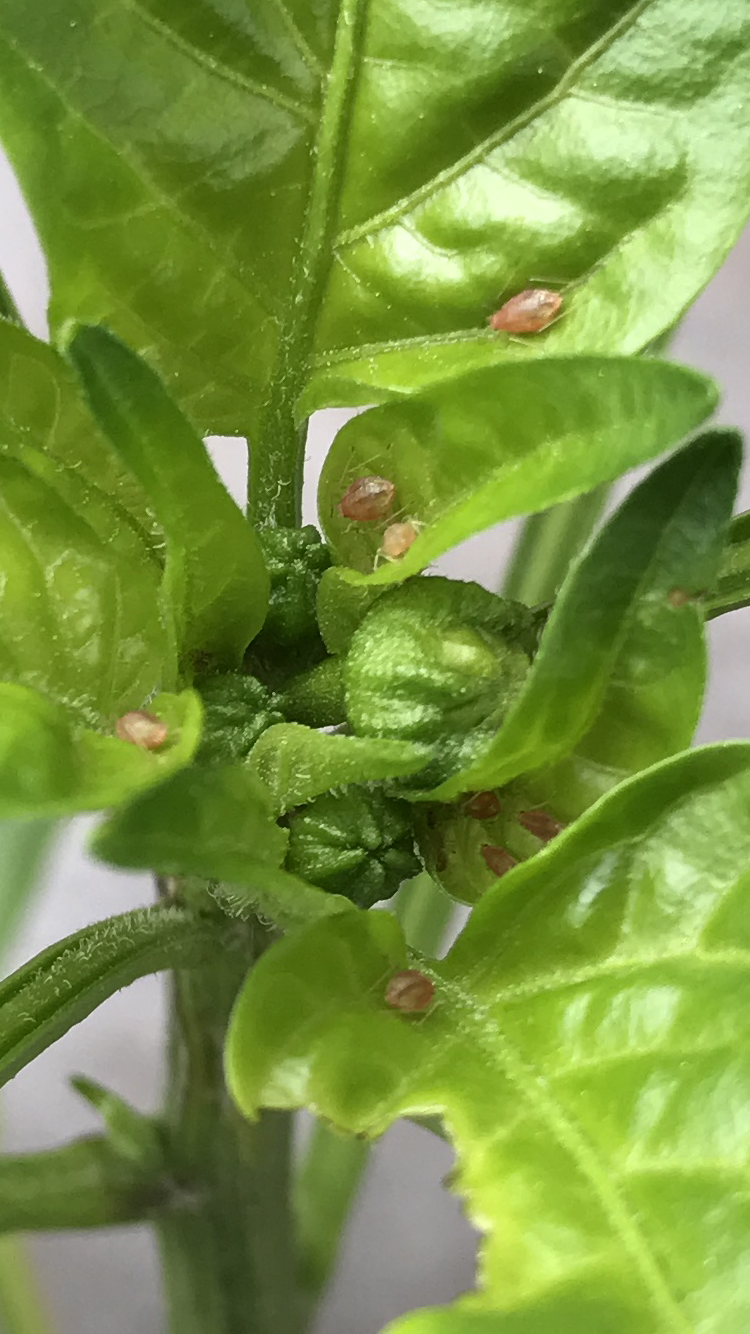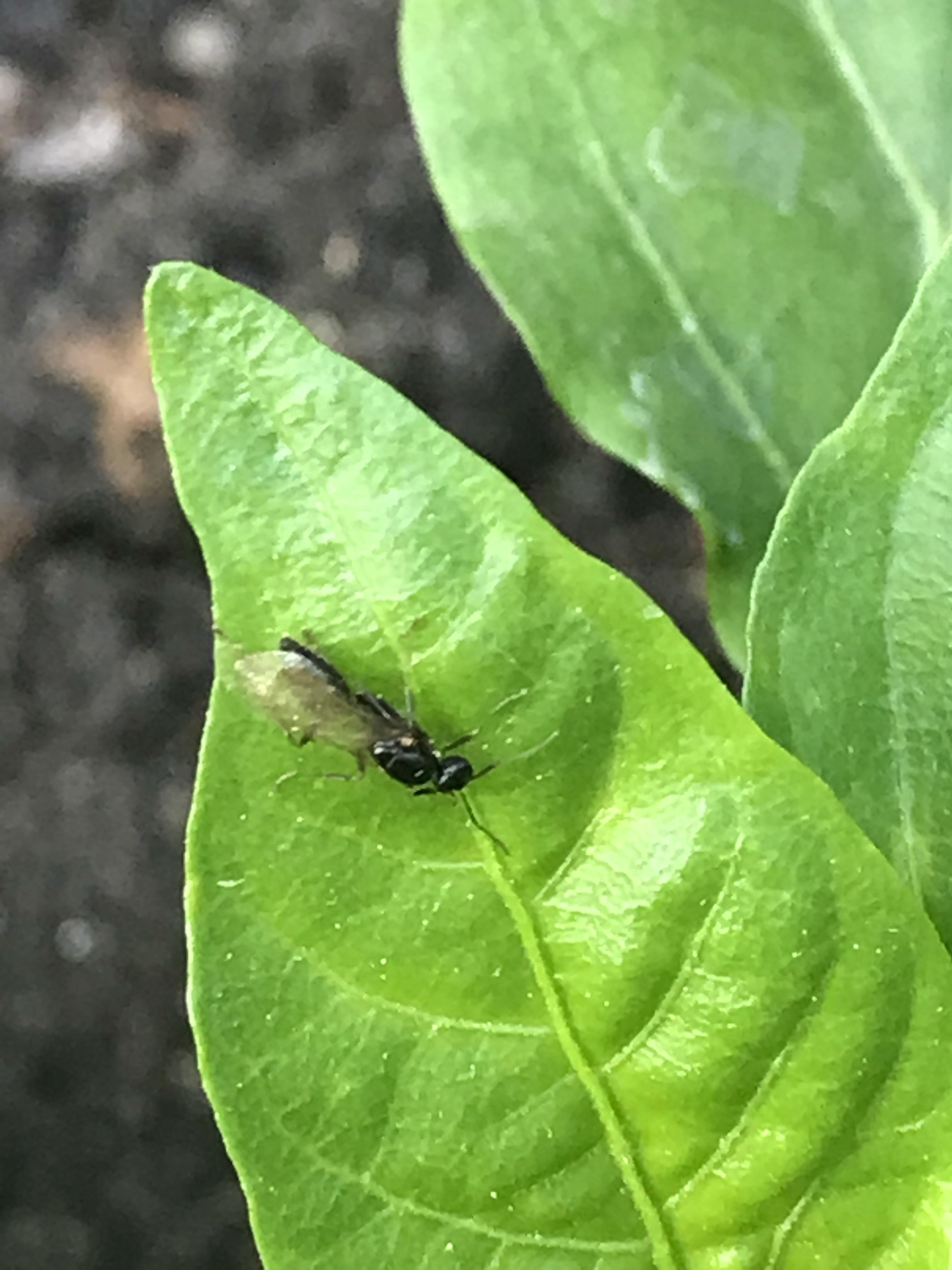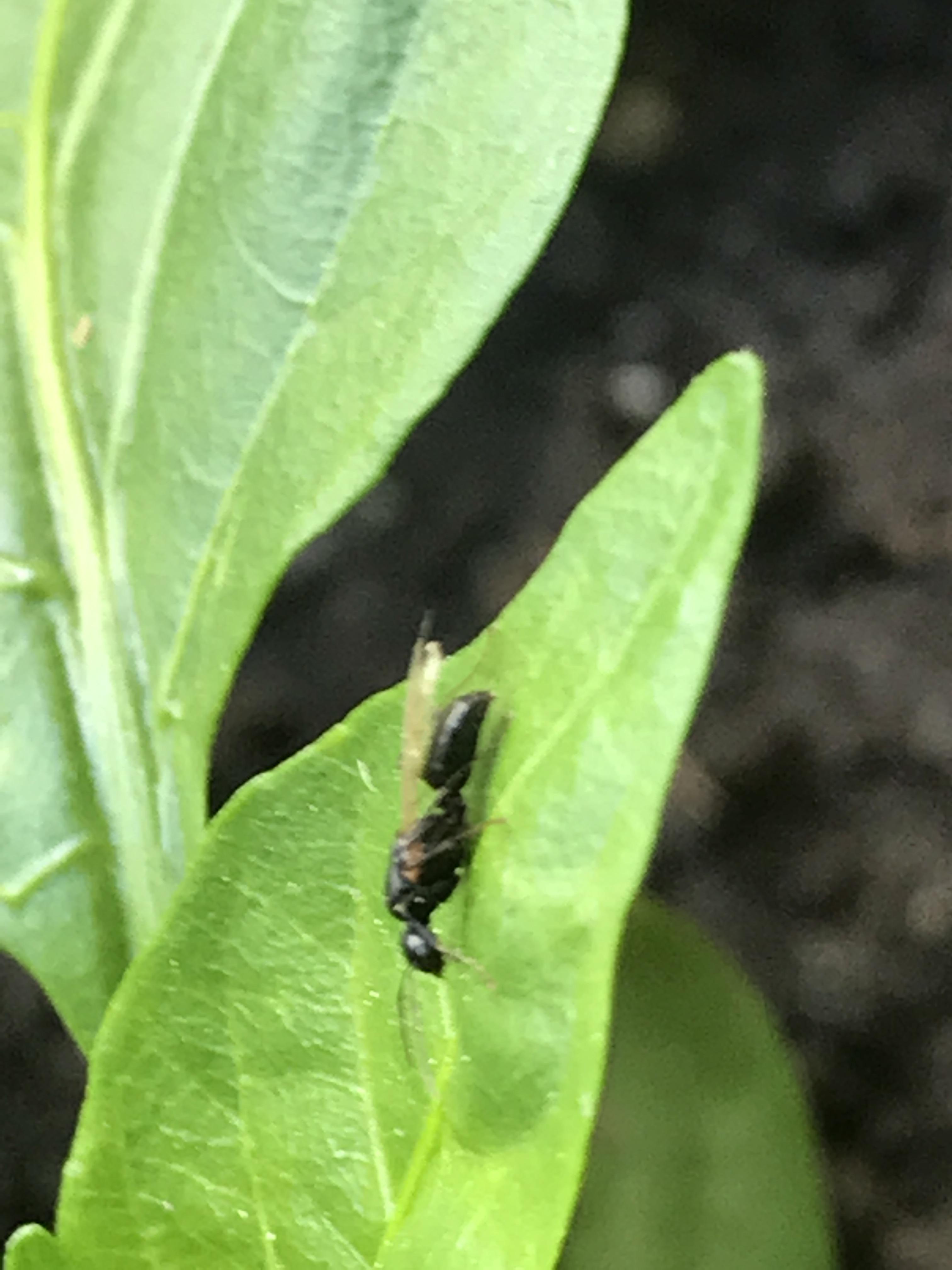-
Do you need help identifying a 🌶️?
Is your plant suffering from an unknown issue? 🤧
Then ask in Identification and Diagnosis. -
✅ Expert and friendly hot pepper grow advice.
✅ The latest information on hot pepper varieties.
✅ Reliable seed trading.
✅ Hot sauce recipes and food safety guidance.
✅ Hot sauce business tips for startups.
🌶️ And more!
It's all here, at The Hot Pepper! The Internet's original hot pepper community! Est. 2004.
You are using an out of date browser. It may not display this or other websites correctly.
You should upgrade or use an alternative browser.
You should upgrade or use an alternative browser.
disease-pests bugs good or bad? new pic post 10
- Thread starter Juice
- Start date
Bad. Badbadbad.kill then damn varmits!
the bad new is that they are aphids, though aphids are very easy to deal with.
the good news is that it looks like there may be parasitic wasps around killing the aphids.
Your photos are not very good so cant confirm 100%, but see the brown looking ones?
Aphids are green, but usually go brown like that before turning into little cocoons after they have had a wasp egg laid inside them.
moral of the story is get some better photos so we can confirm if you should be getting rid of them, or leaving them be. If they are indeed getting eggs laid in them by the wasps (im 80% positive based off your crappy pics) then you certainly want to let those hatch & not remove them from the plant.
e.g. see below image. The green bugs are aphids. Those brown looking cocoon type things are aphids that have been parasited. The yellowish looking ones are dead/dying ,have been parasited and are in the process of turning into one of the brown cocoons.
DO NOT REMOVE OR SPRAY THE BROWN ONES! Let them hatch. They will hatch into more wasps, that will kill more aphids. And the cycle continues

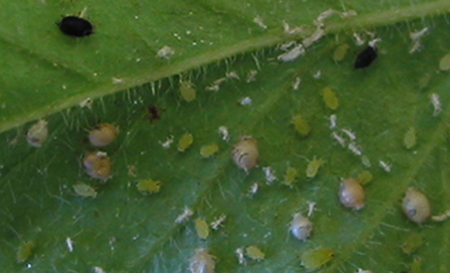
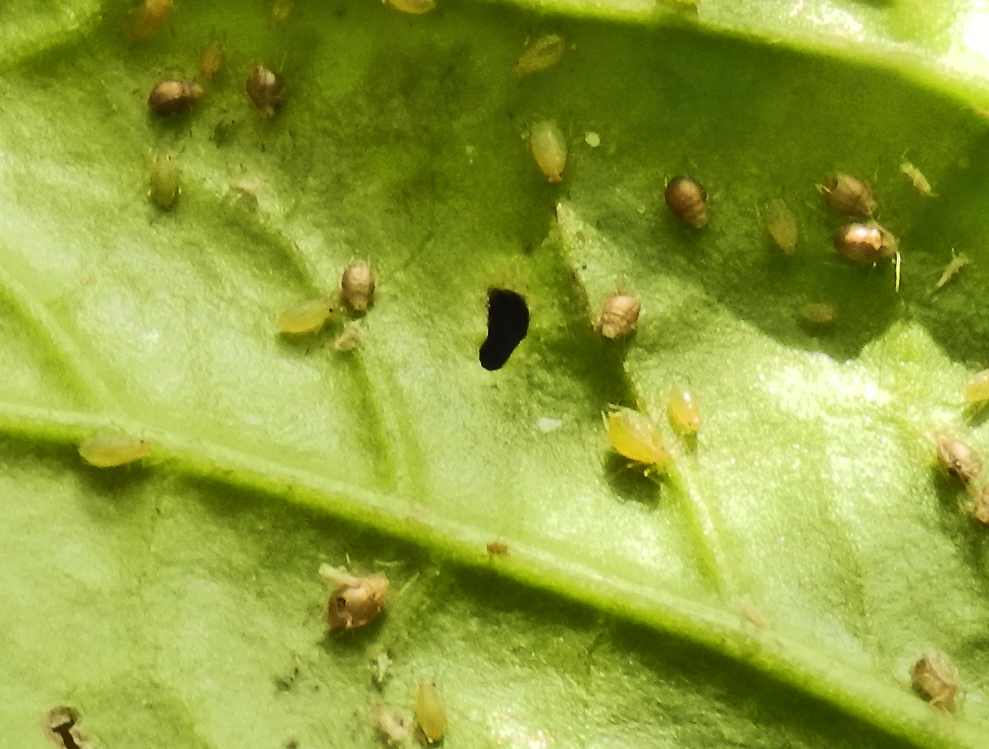
the good news is that it looks like there may be parasitic wasps around killing the aphids.
Your photos are not very good so cant confirm 100%, but see the brown looking ones?
Aphids are green, but usually go brown like that before turning into little cocoons after they have had a wasp egg laid inside them.
moral of the story is get some better photos so we can confirm if you should be getting rid of them, or leaving them be. If they are indeed getting eggs laid in them by the wasps (im 80% positive based off your crappy pics) then you certainly want to let those hatch & not remove them from the plant.
e.g. see below image. The green bugs are aphids. Those brown looking cocoon type things are aphids that have been parasited. The yellowish looking ones are dead/dying ,have been parasited and are in the process of turning into one of the brown cocoons.
DO NOT REMOVE OR SPRAY THE BROWN ONES! Let them hatch. They will hatch into more wasps, that will kill more aphids. And the cycle continues



I'm hard-pressed to think of having aphids on my food plants. I have milkweed in my yard and their an aphid trap. Which creates ladybug factories.
Well, yesterday, for the first time ever, I noticed aphids on my eggplant! I was surprised - they're usually just flea beetle feed. I only saw them on one leaf, so I smooshed them, then went to refill my watering can. By the time I returned, there was an adult and nymph ladybug on the case, patrolling my eggplants! Regardless, now I need to be vigilant of all my eggplants, peppers, and tomatoes.
Well, yesterday, for the first time ever, I noticed aphids on my eggplant! I was surprised - they're usually just flea beetle feed. I only saw them on one leaf, so I smooshed them, then went to refill my watering can. By the time I returned, there was an adult and nymph ladybug on the case, patrolling my eggplants! Regardless, now I need to be vigilant of all my eggplants, peppers, and tomatoes.
nzchili said:the bad new is that they are aphids, though aphids are very easy to deal with.
the good news is that it looks like there may be parasitic wasps around killing the aphids.
Your photos are not very good so cant confirm 100%, but see the brown looking ones?
Aphids are green, but usually go brown like that before turning into little cocoons after they have had a wasp egg laid inside them.
moral of the story is get some better photos so we can confirm if you should be getting rid of them, or leaving them be. If they are indeed getting eggs laid in them by the wasps (im 80% positive based off your crappy pics) then you certainly want to let those hatch & not remove them from the plant.
e.g. see below image. The green bugs are aphids. Those brown looking cocoon type things are aphids that have been parasited. The yellowish looking ones are dead/dying ,have been parasited and are in the process of turning into one of the brown cocoons.
DO NOT REMOVE OR SPRAY THE BROWN ONES! Let them hatch. They will hatch into more wasps, that will kill more aphids. And the cycle continues
YES!
Do not spray or otherwise molest the bugs until you are sure there are no wasps present. If there are wasps, they will very quickly eradicate 98% of the aphids.
Juice said:all i see is the brown bugs, and no green/yellow ones they are mainly on the topside of the leaf not the underside like shown in first pic
That is good. That means that the vast majority have met their demise at the hands of the parasitic wasps.
Keep an eye on a coupe and watch for changes.
I would be willing to bet that the ones you decide to "watch" never move whatsoever (as they are dead), and will continue to go browner and turn into the cocoons I pictured.
Aphids can be anywhere. Under leaves, on top of them, or both.
It does not mean anything that your images had them on top of leaves and not underneath.
Geonerd said:
YES!
Do not spray or otherwise molest the bugs until you are sure there are no wasps present. If there are wasps, they will very quickly eradicate 98% of the aphids.
I think they already have judging by the latest pic. Those are aphids, and they AINT happy!
The little white things on the smaller middle picture. What are they. I am having an aphid issue too.nzchili said:the bad new is that they are aphids, though aphids are very easy to deal with.
the good news is that it looks like there may be parasitic wasps around killing the aphids.
Your photos are not very good so cant confirm 100%, but see the brown looking ones?
Aphids are green, but usually go brown like that before turning into little cocoons after they have had a wasp egg laid inside them.
moral of the story is get some better photos so we can confirm if you should be getting rid of them, or leaving them be. If they are indeed getting eggs laid in them by the wasps (im 80% positive based off your crappy pics) then you certainly want to let those hatch & not remove them from the plant.
e.g. see below image. The green bugs are aphids. Those brown looking cocoon type things are aphids that have been parasited. The yellowish looking ones are dead/dying ,have been parasited and are in the process of turning into one of the brown cocoons.
DO NOT REMOVE OR SPRAY THE BROWN ONES! Let them hatch. They will hatch into more wasps, that will kill more aphids. And the cycle continues



tctenten said:The little white things on the smaller middle picture. What are they. I am having an aphid issue too.
To be honest im not completely sure.
I THINK the little white things are just shedded aphid skins / whats left after the wasps hatch out of the aphid. But im guessing.
I will try and get some pics tomorrow. My plants are big enough to withstand it, but this is the worst I have had. I didn't realize those brown ones were good, pretty sure I squished a bunch.nzchili said:
To be honest im not completely sure.
I THINK the little white things are just shedded aphid skins / whats left after the wasps hatch out of the aphid. But im guessing.
Thanks for the info.
ok thanks for the tips 
they do move slowly i sprayed the first batch i seen on a few plants then most the other plants showed them after.
all of them being brown slow moving, i think i have seen a wasp as shown in the vid around the plants so looks like nature has taken over to help me out
hot pepper plants im growing include
chocolate scorpion
an orange ghost
aji amarillo
brazilian starfish
petter pepper
white hab
reaper
hot purira
trinadad perfume
they do move slowly i sprayed the first batch i seen on a few plants then most the other plants showed them after.
all of them being brown slow moving, i think i have seen a wasp as shown in the vid around the plants so looks like nature has taken over to help me out
hot pepper plants im growing include
chocolate scorpion
an orange ghost
aji amarillo
brazilian starfish
petter pepper
white hab
reaper
hot purira
trinadad perfume
So hear are some pics. Any comments are appreciatednzchili said:the bad new is that they are aphids, though aphids are very easy to deal with.
the good news is that it looks like there may be parasitic wasps around killing the aphids.
Your photos are not very good so cant confirm 100%, but see the brown looking ones?
Aphids are green, but usually go brown like that before turning into little cocoons after they have had a wasp egg laid inside them.
moral of the story is get some better photos so we can confirm if you should be getting rid of them, or leaving them be. If they are indeed getting eggs laid in them by the wasps (im 80% positive based off your crappy pics) then you certainly want to let those hatch & not remove them from the plant.
e.g. see below image. The green bugs are aphids. Those brown looking cocoon type things are aphids that have been parasited. The yellowish looking ones are dead/dying ,have been parasited and are in the process of turning into one of the brown cocoons.
DO NOT REMOVE OR SPRAY THE BROWN ONES! Let them hatch. They will hatch into more wasps, that will kill more aphids. And the cycle continues



I put this leaf in a container to see what happens, but the 2 white ones in the middle should hatch a wasp?
Is this last one a wasp or just an ant?
Sorry but I am clueless when it comes to these bugs.



